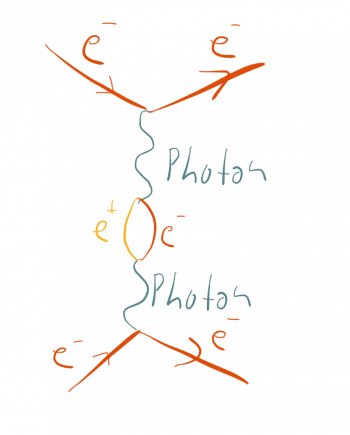Add a new page:
also known as Quantum Fluctuations
 A quantum vacuum fluctuation is a process where from the vacuum a pair of particle and antiparticle emerge and subsequently vanish again.
A quantum vacuum fluctuation is a process where from the vacuum a pair of particle and antiparticle emerge and subsequently vanish again.
The particle and antiparticle pop into existence and then vanish again. The particles that appear in such a process are known as virtual particles.
A quantum vacuum fluctuation does not violate the conservation of any charge since a particle and antiparticle are created at the same time which carry exactly the opposite charges.
The energy that is necessary to create the particle-antiparticle pair is "borrowed" from the vacuum which is in agreement with the "energy-time" uncertainty principle as long as the pair vanishes fast enough again. Similarly, the necessary momentum is borrowed from the vacuum which is allowed thanks to the "momentum-location" uncertainty principle.
 Since such processes are allowed in quantum mechanics the vacuum is never really empty. Instead, it is a boiling sea of particles-antiparticle pairs that pop into existence and then vanish again.
Since such processes are allowed in quantum mechanics the vacuum is never really empty. Instead, it is a boiling sea of particles-antiparticle pairs that pop into existence and then vanish again.
These vacuum fluctuation can be observed, for example, in the form of the famous Casimir effect. Here an attractive force between two plates is measured which is a result of the vacuum fluctuations.
Another instance where virtual particles appear is in particle interactions. When two particles, like two electrons collide it can happen that the photon, which is responsible for the interaction, is converted into a electron-positron pair and then back into the photon. These virtual particles must be taken into account in calculations to get the correct results.
Recommended Resources
Virtual particles appear in quantum field theory as higher order corrections to scattering amplitudes. At tree level two particles scatter, for example, by simply exchanging a photon. The first order correction in perturbation theory can be interpreted as an additional process where the photon becomes virtual electron-positron pair and then again back a photon.
The total cross section is the sum over all such possible processes. At higher orders more and more virtual particles can appear. However, processes with many virtual particles are increasingly unlikely and therefore it is a valid approximation to only consider the first few order in perturbation theory.
Recommended Resources
Talk about quantum fluctuations can be vague. There are really 3 different types of fluctuations: Boltzmann, Vacuum, & Measurement.
The calculational tool represented by Feynman diagrams suggests an often abused picture according to which “real particles interact by exchanging virtual particles”. Many physicists, especially nonexperts, take this picture literally, as something that really and objectively happens in nature. In fact, I have never seen a popular text on particle physics in which this picture was not presented as something that really happens. Therefore, this picture of quantum interactions as processes in which virtual particles exchange is one of the most abused myths, not only in quantum physics, but in physics in general. Indeed, there is a consensus among experts for foundations of QFT that such a picture should not be taken literally. The fundamental principles of quantum theory do not even contain a notion of a “virtual” state. The notion of a “virtual particle” originates only from a specific mathematical method of calculation, called perturbative expansion. In fact, perturbative expansion represented by Feynman diagrams can be introduced even in classical physics [52, 53], but nobody attempts to verbalize these classical Feynman diagrams in terms of classical “virtual” processes. So why such a verbalization is tolerated in quantum physics? The main reason is the fact that the standard interpretation of quantum theory does not offer a clear “canonical” ontological picture of the actual processes in nature, but only provides the probabilities for the final results of measurement outcomes. In the absence of such a “canonical” picture, physicists take the liberty to introduce various auxiliary intuitive pictures that sometimes help them think about otherwise abstract quantum formalism. Such auxiliary pictures, by themselves, are not a sin. However, a potential problem occurs when one forgets why such a picture has been introduced in the first place and starts to think on it too literally. Quantum mechanics: Myths and facts by H. Nikolic
There are no real one-particle systems in nature, not even few-particle systems. The existence of virtual pairs and of pair fluctuations shows that the days of fixed particle numbers are over." Viki Weisskopf